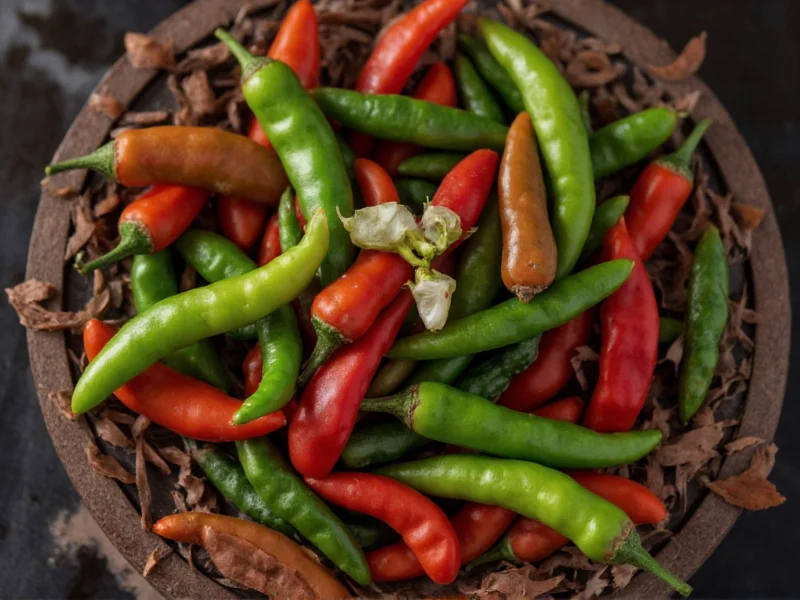The Botanical Identity of True Pepper
When discussing pepper's origin, it's crucial to distinguish between true pepper (Piper nigrum) and other plants commonly called "pepper." Black, white, and green pepper all come from the same flowering vine species native to India's Western Ghats mountain range. This perennial climbing plant produces small berries called 'peppercorns' that transform into different pepper varieties based on harvesting and processing methods.
In contrast, chili peppers belong to the Capsicum genus native to the Americas, while bell peppers and paprika come from different Capsicum species. This botanical distinction explains why black pepper has a unique pungent flavor profile compared to the capsaicin-based heat of chili peppers.
Ancient Trade Routes and the Spice's Global Journey
Pepper's journey from Indian forests to global kitchens began through ancient maritime trade routes. Indian merchants traded pepper with Babylonians as early as the second millennium BCE, and it appeared in Egyptian tombs from 1200 BCE. The Romans established direct sea routes to India specifically for pepper, valuing it so highly that it functioned as currency in some transactions.
During the Middle Ages, pepper became Europe's most sought-after spice, driving exploration that eventually led to the Age of Discovery. Portuguese explorer Vasco da Gama's 1498 voyage to India was motivated primarily by the desire to control the lucrative pepper trade, which had previously passed through multiple intermediaries, dramatically increasing its price.
| Top Pepper-Producing Countries | Annual Production (Metric Tons) | Global Market Share |
|---|---|---|
| Vietnam | 280,000 | 34% |
| India | 75,000 | 9% |
| Brazil | 40,000 | 5% |
| Indonesia | 25,000 | 3% |
| Madagascar | 20,000 | 2% |
From Kerala to Worldwide Cultivation
While India remains culturally and historically significant as pepper's birthplace, global production has shifted dramatically. Vietnam now dominates the market, producing over one-third of the world's pepper. This shift began in the late 20th century when Vietnamese farmers adopted high-yield cultivation techniques in the Central Highlands region.
The reason pepper thrives in these diverse locations relates to its specific growing requirements: tropical climates with consistent temperatures between 75-85°F (24-29°C), high humidity, and well-drained soil. These conditions exist across equatorial regions, allowing successful cultivation from Southeast Asia to Central Africa and parts of South America.
Processing Methods That Create Different Pepper Varieties
The same Piper nigrum berry transforms into various pepper types through different processing:
- Black pepper: Unripe green berries sun-dried until they shrivel and turn black
- White pepper: Ripe red berries soaked to remove outer layer, leaving white seed
- Green pepper: Unripe berries preserved through freeze-drying or brining
- Red pepper: Fully ripe berries dried with outer layer intact
Each method affects the flavor profile, with black pepper offering the most complex, pungent taste due to enzymatic reactions during drying, while white pepper provides a cleaner, more earthy flavor preferred in light-colored dishes.
Pepper's Cultural and Economic Significance Through History
Pepper's value extended far beyond culinary use throughout history. In medieval Europe, it served as collateral for loans, payment for taxes, and even dowries. The Dutch once exchanged the island of Manhattan for the tiny Indonesian island of Run, one of the world's primary sources of nutmeg and mace, demonstrating the extraordinary value placed on spices.
Historical records show that in 410 CE, when Rome fell to the Visigoths, the invaders demanded 3,000 pounds of pepper among their ransom. In ancient Greece and Rome, pepper appeared in medical texts as a treatment for various ailments, while Ayurvedic medicine in India has utilized pepper for digestive and respiratory health for millennia.
Modern Pepper Production and Sustainability Challenges
Today's pepper industry faces significant challenges including climate change impacts, price volatility, and sustainability concerns. Traditional shade-grown methods in Kerala contrast with Vietnam's intensive monoculture farming, raising questions about long-term environmental impact.
Recent innovations focus on improving yield while maintaining quality, with researchers developing disease-resistant varieties and more sustainable farming practices. The growing specialty market for single-origin, organic, and fair-trade pepper reflects consumers' increasing interest in traceability and ethical production.











 浙公网安备
33010002000092号
浙公网安备
33010002000092号 浙B2-20120091-4
浙B2-20120091-4